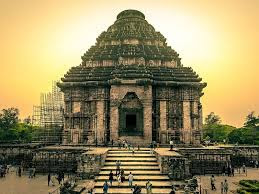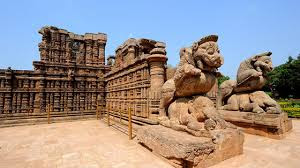BLACK PAGODA - Konark Sun Temple
Hey friends I like to share my BLACK PAGODA journey with you but one day before visiting Konark sun temple lot of thoughs was running in my mind lke who build this? for what purpose? when? why? amd many more....This all running thought was goes off when I'm in front of the konark sun temple it was huge, awesome, amazing and many more
I"m sure that you are also planning to visiting the konark sun temple So,let me help you without losing the time lets explore the BLACK POGODA - KONARK SUN TEMPLE
Meaning of Black Pagoda, why konark sun temple called black pagoda?.......
Pagoda is generally a Hinduism or buddhism temple. This name is given by Europeans to Hindu temples. Konark sun temple being black in colour, is called black pagoda. Konark sun temple also has great magnetic power which draws ships to it and became reason of some ships breaking, that is also one of the factor that "black" is attached with it.
Great History of Black Pagoda....
Konark Sun Temple dates back to 1250 AD. The construction of the temple is credited to King Narasimhadeva I, a warrior and monarch of the Eastern Ganga Dynasty. This giant temple was built near an old temple dedicated to Surya, the Sun God. Inscriptions dating back to the era indicate that the sculpture in that older temple was re-consecrated into the new temple. It is believed that this elaborately carved temple was built over a period of 12 and with the help of 12,000 artisans.
Several ancient texts eulogize the marvelous beauty of Konark Sun Temple, which was an active place of worship until at least the middle of the 16th century. However, the grand structure wasn’t able to escape the damage and destruction caused by time. It is not clear as to what caused its large-scale destruction to the extent that the main temple structure was completely ruined. Some historians suggest that the temple was damaged due to natural causes while some others imply that the temple was intentionally damaged by Muslim invaders, mainly Kalapahad, a general of Gour Sultanate. Whatever be the cause, the temple suffered extensive damage between 1556 and 1800.
During the last part of the 18th century, an ornamented pillar called Aruna Stambha was relocated from Konark Sun Temple to the famous Jagannath Temple in Puri, which stands there to this day. The existing portion of the temple was partially restored by the archaeological teams of the British-era. The temple was declared a UNESCO World Heritage Site in 1984.
Architecture....
The Sun Temple in Konark exhibits the traditional Odisha style of architecture, also known as Kalinga architecture, on a grand scale. It is designed as a massive chariot mounted on 12 pairs of intricately carved giant stone wheels that are drawn by a set of seven mighty stone horses. The temple is built with such a fine slant towards the east that the first rays of the rising sun illuminate the main entrance. This main entrance is ornamented with two huge stone lions standing on both sides. Both these lions are shown as trampling an elephant and a man beneath.
The temple complex spreads over 26 acres of land. Three kinds of stones were used in its construction, namely Chlorite, Laterite, and Khondalite rocks. The original temple consisted of the main sanctuary, called Bada Deul or Rekha Deul, which was surrounded by other smaller structures. In front of the main sanctuary stood another smaller sanctum called the Bhadra Deul or the assembly hall of the people. It is believed that the main sanctuary had a height of around 225 feet, but not much remains of that structure.
What survived through the ages is the smaller sanctum, which is a magnificent structure in itself. It has a height of around 100 feet and is adorned with exquisite stone carvings all over. This sanctum is celebrated for its intricate artwork, themes, and iconography that include erotic depictions as well, much like the Khajuraho Temple in Madhya Pradesh. Apart from this smaller sanctum, a few other structures and sanctums have also survived. These include the Nata Mandir or the dancing hall, the nine planets temple, and the kitchen or Bhoga Mandapa.
The story of wheels at Konark sun temple......
As the temple was built like a chariot of Sun god. The wheels of the chariot has lot of engraved art work around its axis and peripheries. There are 24 wheels fixed to the temple and is of 9 feet 9 inches in diameter and they are having 8 spokes. All stone wheels are full with engraved art works. Out of 24 wheels 6 are in either side of the main temple, 4 wheels are on each side of the Mukhasala and 2 wheels on each side of steps at eastern front. The 24 wheels signifies 24 hours of a day and the 8 spokes signifies prahars ( three hour period ) of a day.
Konark Wheel is used in Government of India official symbol and in some currency notes of Indian rupees.
Mayadevi temple........
Located west-southwest from the entrance of the main temple, it has been dated to the late 11th century, earlier than the main temple. It consists of a sanctuary, a mandapa and, before it, an open platform. It was discovered during excavations carried out between 1900 and 1910. Early theories assumed that it was dedicated to Surya's wife and thus named the Mayadevi Temple. However, later studies suggested that it was also a Surya temple, albeit an older one that was fused into the complex when the monumental temple was built. This temple also has numerous carvings and a square mandapa is overlain by a sapta-ratha. The sanctum of this Surya temple features a Nataraja. Other deities in the interior include a damaged Surya holding a lotus, along with Agni, Varuna, Vishnu, and Vayu.
Vaishnava temple.....
Located southwest of the so-called Mayadevi Temple, it was discovered during excavations in 1956. This discovery was significant because it confirmed that the Konark Sun Temple complex revered all the major Hindu traditions, and was not an exclusive worship place for the saura cult as previously believed. This is a small temple with sculptures of Balarama, Varaha, and Vamana–Trivikrama in its sanctum, marking it as a Vaishnavite temple. These images are shown as wearing dhoti and a lot of jewelry. The sanctum's primary idol is missing, as are images from some niches in the temple. The site's significance as a place of Vaishnavism pilgrimage is attested to in Vaishnava texts. For example, Krishna Chaitanya, the early 16th-century scholar and founder of Gaudiya Vaishnavism, visited the Konark temple and prayed on its premises.
How to reach Konark Sun Temple
Konark Sun Temple is situated in Konark, a town in the district of Puri in Odisha. It is approximately 60 km from the capital Bhubaneswar and 35 km from Puri. Konark is a famous tourist destination owing to the Sun Temple and thus it is well-connected to Puri and Bhubaneswar by trains, buses and taxis. The easiest way however, to reach Konark is to rent a cab from Puri.
Nearest Bus Stand to Konark Sun Temple:
Konark Bus Stand is 6 minutes from the Sun Temple. You can board a bus from Puri and reach Konark in an hour. OSRTC and private operators provide bus service from Puri to Konark.
Nearest Railway Station to Konark Sun Temple:
Puri Railway Station is the nearest railway station from the Konark Temple. It is 30 km from Konark. You can book Bhubaneswar to Puri trains and then take a taxi to reach the temple.
Nearest Airport to Konark Sun Temple:
Bhubaneswar Airport or Biju Patnaik International Airport is 65 km and around an hour-long drive from the Konark Sun Temple. You can easily get taxis on hire to reach Konark from the airport.
Konark Sun Temple Timings
Konark Sun Temple timings are 6 am to 8 pm
.













Comments
Post a Comment